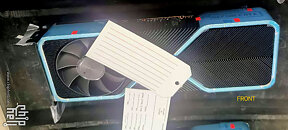Saturday, June 6th 2020

NVIDIA GeForce RTX 3080 Pictured?
Here are what could be the very first pictures of a reference NVIDIA GeForce RTX 3080 "Ampere" graphics card revealing an unusual board design, which is the biggest departure in NVIDIA's design schemes since the original GeForce TITAN. It features a dual-fan aluminium fin-stack cooler, except that one of its fans is located on the obverse side, and the other on the reverse side of the card. The PCB of the card appears to extend only two-thirds the length of the card, ending in an inward cutout, beyond which there's only an extension of the cooling solution. The cooler shroud, rather than being a solid covering of the heatsink, is made of aluminium heatsink ridges. All in all, a very unusual design, which NVIDIA could implement on its top-tier SKUs, such as the RTX 3080, RTX 3080 Ti, and in a cosmetic form on lower SKUs. We get the feeling that "Cyberpunk 2077" has influenced this design.
Sources:
ChipHell Forums, HXL (Twitter), VideoCardz



225 Comments on NVIDIA GeForce RTX 3080 Pictured?
Remember, the fan is on the rear side = PCB side, so there's no room for both a PCB AND a fan at the same spot. (Unless there are two PCB's, not very likely.)
The whole reasoning came from the idea that it would work like this. (Old GTX 960 as an example)
Air going straight through, just like I and at least two others tried to explain with excellent Paint skills. Then I realized that there's probably a vapor chamber in the way, so it's not possible.
This isn't about me being right or wrong, just a chain of thoughts.
Do you feel up to date now?
Either way, this design seems problematic.
As for convection, even the weakest fan can beat that easily, so the absolute direction of airflow only really matters if you're designing specifically to utilize convection in the first place. If you have a front intake and rear exhaust on your case, convection inside of the case is near meaningless.Problematic in terms of maximising cooling potential per volume while maintaining compatibility. I obviously also assume this has been tested extensively if it is real at all, but nonetheless it stands out as an example of engineering for the sake of engineering (and partially for the sake of looking like engineering, of course) rather than aiming to make as optimal a design as possible. Design simplicity is not a quality Nvidia tends to favor though, what with the near infinite number of screws on their founders edition coolers, so I wouldn't put it past them to say "screw it, let's ignore complexity altogether and just make something we think is cool".
Maybe as you said it's a mixed cooling solution , vapor chamber for core/memory and heat pipes ( which will allow the fan to blow downwards ) for the VRM .
who puts a vapor chamber on vrm ?
I mean on the classic FE cooler VRM is cooled by the vapor chamber ( indirectly ) but yeah an entire vapor chamber dedicated to VRM seems a bit excessive especially considering those GPUs are expected to have massively improved power efficiency .
GJ NVIDIA!
New renders:
videocardz.com/newz/nvidia-geforce-rtx-3080-gets-a-better-look-in-unofficial-3d-renders
The front fan obviously exhausts out via the angled slots in the centre section. I'll assume this section is covered in a vapor chamber and with closed sides around the fan as well, the choice of an axial fan instead of a radial fan is an odd one - probably chosen for looks rather than functionaliy.
The rear fan obviously exhausts through the front of the card - you can just about see the heatpipes in the photo of the rear of the card.
Personally, I think the PCIe power cables will go along the top edge, right by the slot cover. I don't see them dumping PCIe power connectors on the end of the card like they did with the RTX 20x0FE because that was a mess even with a simple single-sided cooler and regular rectangular PCB.
After exchange rate to Cnd$ and 13% tax, I think I'd rather have a whole set of new appliances instead.
was thinking about cpu upgrade.3600/10400f + mobo + ddr4
for what it would cost me I got a new case (with extra fans),new heaphones with a dac and a new printer.
ampere/rdna2 is a must buy tho.I bought a card every gen cause I just like new stuff.started with 7870-290-980-980ti-1080-1080Ti-2070S.